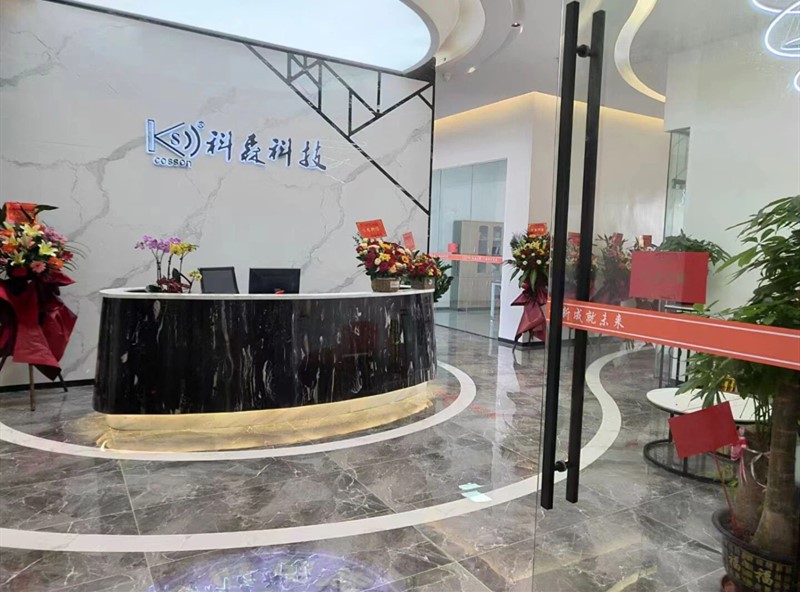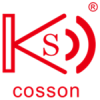Ultrasonic Sensor
Foshan cosson Technology Co. Ltd is a professional enterprise engaged in manufacturing buzzer,sensor, piezeceramic, speaker and so on . The company is located in Guandong. Since its inception the company spirit of "Quality first, customer first" business philosophy, full participation, excellence, to provide high-quality products for customers !
Cosson has talent, technology, quality, service, strategy and other advantages.Meanwhile,it is optimizing work flow, casting excellence, continuing to revitalize the brand to maintain the leading position, the vision of a more broad, higher goals and dedicated to creating more value for customers. The company has developed a series of products which are widely used in the production: communication, household appliances, automobiles, electric bicycles, UPS power supply, alarm; instrumentation, electronic toy and electronic clocks and so on.

Why choose us?
01
Quality assurance
Quality is our culture, we believe that the quality is the soul of an enterprise.
02
Good service
Good after-sale service, handling the customer complaint and solve problem for customers.
03
Reasonable price
Our products are complete in variety, good in quality, reasonable in price.
04
Fast delivery
We may promise that we can try our best to finish all of your orders within the shortest time.
What is Ultrasonic Sensor
Ultrasonic sensors are electronic devices that determine a target’s distance. They work by emitting ultrasonic sound waves and converting those waves into electrical signals. Furthermore, ultrasonic travel at a faster rate than audible sounds. Therefore, ultrasonic sensor work involves sound waves to find the distance to an item. A transducer is also there to transmit and receive ultrasonic pulses. These pulses help to communicate information about an object within range. Further, this detail can be applied in various applications including industrial.
Benefits of Ultrasonic Sensor
This sensor could have easily sensed the nature, shape and orientation of that specific object which is within the area of these sensors so sensing capability to sense all the material types.
These sensors have greater accuracy than another method for measuring the thickness and depth of the parallel surface.
This sensor easily interfaces with a microcontroller or any type of controller.
This sensor has high frequency, high sensitivity and high penetrating power, therefore, it can easily detect the external or deep object.
It can work in any adverse conditions.
Their sensor is easy to use, not dangerous during operation for nearby object person, equipment or material.
This sensor is not affected due to atmospheric dust, rain, and snow.
It provides a good reading in sensing large-sized objects with hard surfaces.
It has a higher sensing distance compare to inductive or capacitive proximity sensor types.
Types of Ultrasonic Sensor
1.Diffuse proximity sensors
Diffuse proximity sensors are the most common type of ultrasonic sensor. They employ a special sonic transducer, which allows for alternate transmission and reception of sound waves. These sensors are ideal for measuring distance in a variety of materials, but they are not as accurate as other types of ultrasonic sensors.
2.Retro-reflective sensors
Retro-reflective sensors are more accurate than diffuse proximity sensors, but they require a clear line of sight between the sensor and the object being measured. These sensors are often used in automotive applications, where they can be used to measure the distance between the car and other objects.
3.Through-beam sensors
Through-beam sensors are the most accurate type of ultrasonic sensor. These sensors work by transmitting a beam of ultrasound waves across space. When the beam hits an object, it is reflected back to the sensor. These sensors are often used in industrial applications, where they can be used to measure the thickness of materials or the level of liquids in a tank.
Distance measurement
Ultrasonic sensors are commonly used for measuring distances without physical contact. They emit high-frequency sound waves and measure the time it takes for the sound waves to bounce back after hitting an object. This is useful in applications like parking assist systems, robotics, and industrial automation.
Obstacle detection
They are used in robotics and autonomous vehicles to detect and avoid obstacles. By constantly measuring distances to nearby objects, they help vehicles navigate safely.
Liquid level measurement
Ultrasonic sensors can determine the level of liquids in tanks or containers, making them valuable in industries such as agriculture, wastewater treatment, and chemical processing.
Object detection and presence sensing
These sensors can detect the presence or absence of objects within a certain range. This is useful in conveyor systems, security systems, and industrial machinery.
Flow measurement
In industries like water management and oil & gas, ultrasonic sensors can be used to measure the flow rate of liquids in pipes.
Level sensing in autonomous vehicles
In self-driving cars and drones, ultrasonic sensors play a role in maintaining a safe distance from the ground and other objects.
Fish finders
In recreational and commercial fishing, ultrasonic sensors are used in fish finders to locate fish beneath the water's surface.
Security systems
Ultrasonic sensors can be part of security systems to detect movement or intruders in a protected area.
Animal detection
In wildlife conservation and agriculture, ultrasonic sensors can be used to detect and monitor the movement of animals.

Ultrasonic sensors work by sending out a sound wave at a frequency above the range of human hearing. The transducer of the sensor acts as a microphone to receive and send the ultrasonic sound. Our ultrasonic sensors, like many others, use a single transducer to send a pulse and to receive the echo. The sensor determines the distance to a target by measuring time lapses between the sending and receiving of the ultrasonic pulse.
The working principle of this module is simple. It sends an ultrasonic pulse out at 40 kHz, which travels through the air, and if there is an obstacle or object, it will bounce back to the sensor. By calculating the travel time and the speed of sound, the distance can be calculated.
Ultrasonic sensors are a great solution for the detection of clear objects. For liquid level measurement, applications that use infrared sensors, for instance, struggle with this particular use case because of target translucence.
For presence detection, ultrasonic sensors detect objects regardless of color, surface, or material (unless the material is very soft, like wool, as it would absorb sound).
To detect transparent and other items where optical technologies may fail, ultrasonic sensors are a reliable choice.
Components of Ultrasonic Sensor
Transmitter
Ultrasonic wave is generated through the vibration of the oscillator (generally ceramic products, with a diameter of about 15 mm) and radiates into the air.
Receiver
When the ultrasonic oscillator receives the ultrasonic wave, corresponding mechanical vibration will occur and convert the ultrasonic wave into electrical energy as the output of the receiver.
Control part
It uses an integrated ultrasonic sensor circuit to control the ultrasonic transmission of the transmitter and determines the size of the received signal and whether the receiver has received the signal (ultrasonic).
Power supply
The ultrasonic sensor is usually powered by an external DC power supply of 12V±10% or 24V±10%, which is supplied to the sensor by an internal voltage stabilizing circuit.
History of the Ultrasonic Sensor
Soviet Scientist Sergei Y. Sokolov is considered the father of modern ultrasonic testing. In 1928, Sokolov successfully demonstrated how to use ultrasonics to detect flaws in metals. Unsurprisingly, Sokolov proposed that this technique would be beneficial in the industrial arena for testing irregularities in solid materials. Sokolov's experimentation laid the groundwork for future developments in ultrasonic testing (Portal of Non-Destructive Testing).
How to Maintain Ultrasonic sensor
Importance of maintenance
Maintenance is key to preserving the functionality and longevity of any equipment, and ultrasonic sensors are no exception. While it’s tempting to assume that sensors can operate flawlessly without intervention, the reality is that environmental factors and regular wear and tear can affect their performance.
Factors affecting ultrasonic sensors
Environmental conditions: Ultrasonic sensors may be exposed to harsh environmental conditions, such as extreme temperatures, humidity, or corrosive substances. These factors can lead to the accumulation of debris or corrosion on the sensor’s surface, affecting its ability to accurately detect objects or measure distances.
Buildup and contamination: Solid or liquid buildup on the sensor’s transducer face can distort ultrasonic waves, resulting in inaccurate readings. Additionally, contaminants in the sensor’s environment can accumulate over time, further compromising its performance.
Temperature variations: Temperature changes can impact the speed of sound waves, affecting the sensor’s calibration and accuracy. Extreme temperature fluctuations may necessitate recalibration or adjustments to maintain optimal performance.
Maintenance practices
Regular maintenance practices can help mitigate potential issues and ensure the continued reliability of ultrasonic sensors. Some essential maintenance tasks include:
Cleaning: Periodically inspecting and cleaning the sensor’s transducer face to remove any buildup or contaminants is crucial for maintaining accuracy. Use appropriate cleaning solutions and techniques to prevent damage to the sensor.
Calibration: Monitoring and recalibrating the sensor as needed, especially after significant temperature changes or environmental shifts, can help maintain accurate measurements.
Inspection: Conducting visual inspections of the sensor and its surroundings to identify any signs of damage, corrosion, or environmental factors that may affect performance.
Protection: Implementing protective measures, such as enclosures or barriers, to shield the sensor from harsh environmental conditions or physical damage can prolong its lifespan.
How to Choose Ultrasonic Sensor
Measurement distance
When selecting an ultrasonic sensor, the appropriate model should be chosen based on the required measurement distance. Generally, the measurement distance of ultrasonic sensors ranges from a few centimeters to several meters.
● If a sensor is too close to an object, it may not be able to measure the distance accurately. If a sensor is too far from an object, it may not detect the object at all. The sensor chosen for a distance measurement application must be properly rated for the expected minimum and maximum measurement distances.
● Factors to consider when determining the useful operating range required (i.e., the material window) include: Material State: Liquids and solids behave differently when hit with soundwaves, which results in different interactions with ultrasonic sensors. Liquid measurements require a sensor with a range at least 25% greater than the expected maximum measurement, while dry measurements require a range at least 50% greater than the expected maximum.
● Material size, shape, and orientation can also impact measurement accuracy, with large, flat water surfaces being easier to detect at a distance than curved or granular objects.
Operating environment
The operating environment of an ultrasonic sensor is also a factor to consider when choosing. Some of the environmental factors to consider when choosing an ultrasonic sensor include:
● Temperature: Temperature, for instance, can impact the speed of sound, affecting the accuracy of distance measured by the sensor.
● Weather: Ice, snow, dust, mud, and other environmental material buildup can block the sensor face, which can prevent the ultrasonic soundwaves from being transmitted or received. Additionally, the ingress of contaminants, such as water, can affect sensor function.
● Pressure/vacuum: Ultrasonic sensors are not designed for use in high-pressure or vacuum applications.
● Ultrasonic noise can sometimes cause interference with measurement operations. Equipment, such as air nozzles, pneumatic valves, and ultrasonic welders, can generate this type of noise.
Accuracy
The measurement accuracy of ultrasonic sensors is also a key factor to consider when choosing. Generally, the higher the measurement accuracy of an ultrasonic sensor, the higher its price.
Operating frequency
The operating frequency of an ultrasonic sensor can also affect its performance. Generally, the higher the operating frequency of an ultrasonic sensor, the higher its measurement accuracy.
Output signal
When choosing an ultrasonic sensor, its output signal type and method should also be considered so that it is compatible with the control system.
Price
The price of an ultrasonic sensor is also a consideration, and the appropriate model should be selected based on actual needs and budget.
Certifications

Our Factory
We attach great importance to, cherish all cooperation or cooperative partner of customers, to express the trust and expectations of our customers.Cosson's team of professional skills, has a very enthusiastic, with a lofty ideals and high aspirations enthusiasm and look forward to customers, together with the Chinese The electronic industry is booming as a modest, attained brilliant. Partnership, abide by integrity, common development!We firmly believe that the goods of electronic will continue to forge ahead, and you work together to create a better future! We hope to work with all of our overseas partners.Let's do it even better!




















